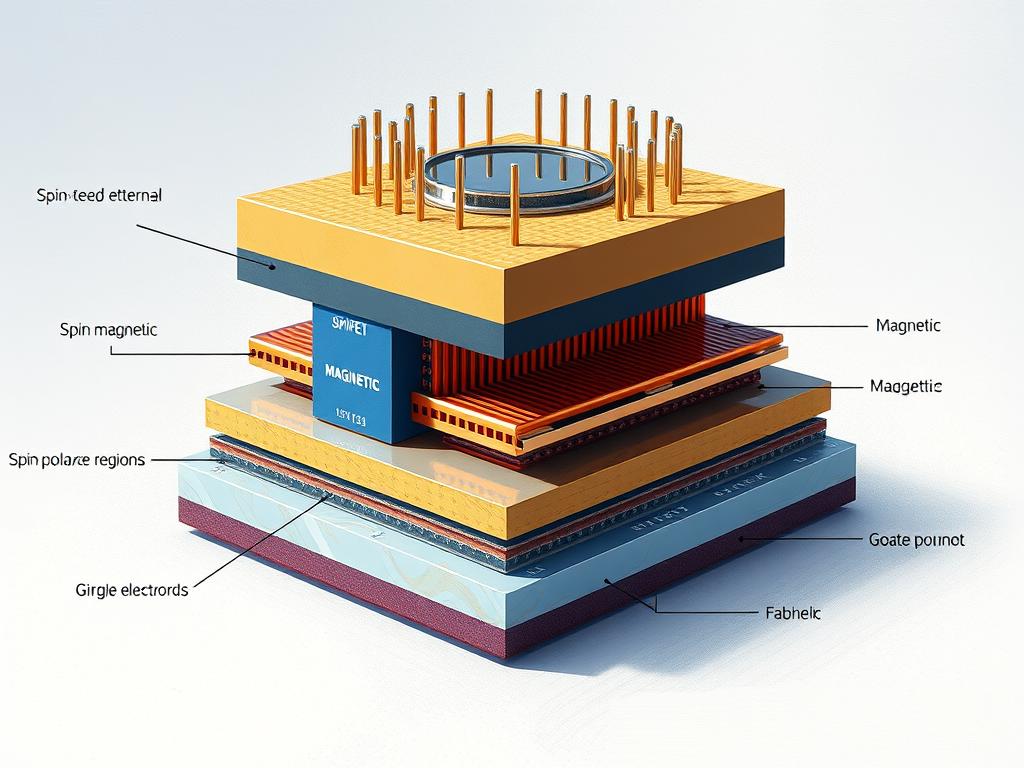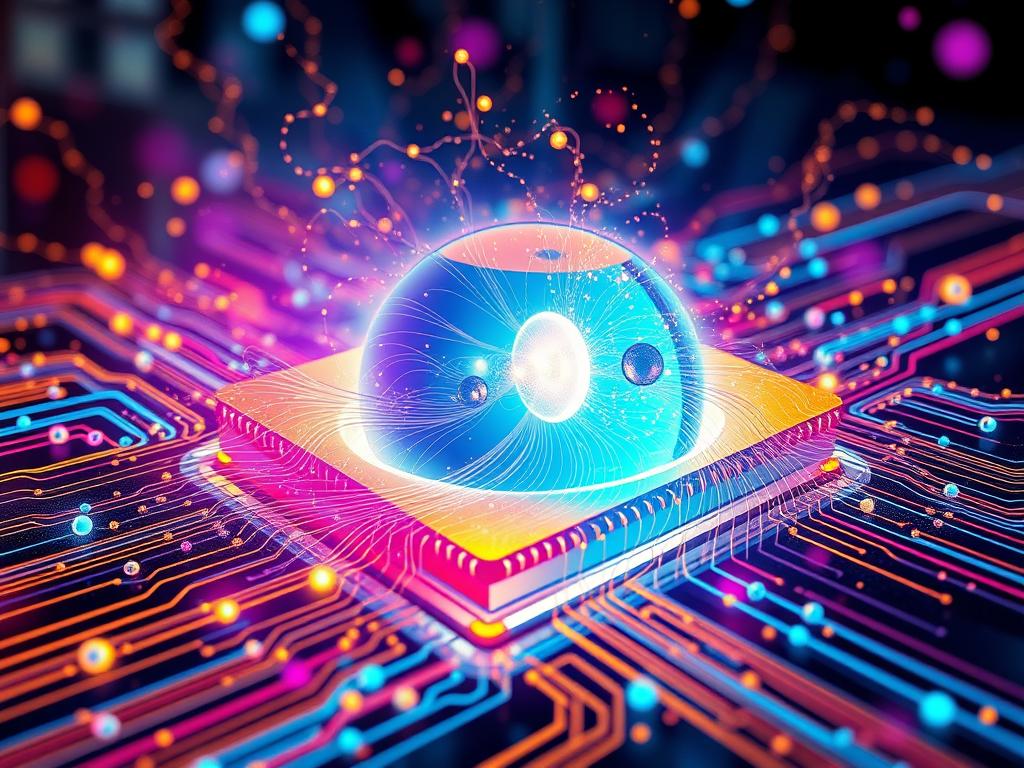Conventional magnetic memories operate at nanosecond speeds. In contrast, spin field-effect transistors (SpinFETs) switch in just 10 picoseconds. This 100-fold speed boost is transforming non-volatile logic circuits.
Spin-orbit coupling powers SpinFET technology. It’s opening doors to faster, more energy-efficient computing. Magneto-electric spin field-effect transistors (ME spin-FETs) lead this innovation.
These devices include anti-ferromagnet spin-orbit read logic and ME spin-FET multiplexers. They work reliably at room temperature with impressive on/off ratios. SpinFETs leverage spin-orbit coupling in semiconductor channels. This enables faster write speeds and lower energy use than traditional CMOS technology.
SpinFETs offer more than just speed. They can operate at temperatures up to 400K. This makes them suitable for various applications. They also need fewer components than CMOS equivalents.
This could lead to more compact and efficient circuit designs. SpinFETs are reshaping non-volatile logic. They’re pushing the limits of computing and electronics technology.
Understanding Spin-Orbit Coupling in Semiconductor Physics
Spin-orbit coupling greatly affects electron behavior in semiconductors. It results from the interaction between an electron’s spin and orbital motion. This phenomenon influences energy levels in atoms and crystal structures.
Definition and Mechanisms
Spin-orbit coupling occurs when electrons move through electric fields. It’s a relativistic effect causing shifts in atomic energy levels. This interaction reveals subtle energy level splitting in atomic spectroscopy.
The effect stems from the interplay of an electron’s magnetic dipole and orbital motion. It also involves the nucleus’s electrostatic field. These factors combine to create fine structure in atomic spectra.
Role in Quantum Mechanics
Spin-orbit coupling is key to understanding atomic structure in quantum mechanics. It explains fine structure in atomic spectra and affects electron energy in atoms. The energy splitting it produces is similar to other relativistic effects.
Applications in Spintronics
Spintronics uses spin-orbit coupling to explore electron spin for technology. In semiconductors, it influences the spin Hall effect and magnetocrystalline anisotropy. These effects are vital for developing new electronic devices.
Such devices use electron spin for information processing and storage. This technology could lead to significant advances in computing and data management.
| System | Electron Density Range (cm^-2) | SOC Effect |
|---|---|---|
| MgZnO/ZnO | 1.7 × 10^11 – 8 × 10^11 | Tunable with Mg-content |
| ZnO | Variable | Interplay with Coulomb interaction |
Recent studies on MgZnO/ZnO systems show exciting results. Scientists can now tune spin-orbit coupling strength by adjusting carrier density. This discovery opens up new possibilities for controlling spin-orbit effects in semiconductors.
These findings could lead to breakthroughs in spintronics and quantum computing. They offer new ways to manipulate electron spin in semiconductor devices.
The Basics of SpinFET Technology
SpinFET technology revolutionizes transistor design by using electron spin for information processing. It blends quantum mechanics principles to create more efficient computing devices. This approach includes Russell-Saunders Coupling and j-j Coupling.
What is a SpinFET?
A SpinFET is a new device that controls current flow using electron spin. It uses the intrinsic angular momentum of electrons to process information. This allows for faster switching speeds and lower energy use.

Key Components and Functionality
A SpinFET’s core is a thin semiconductor channel with strong spin-orbit coupling. Materials like InGaAs or InSb are used for their spin properties. The gate often has a magnetoelectric antiferromagnet.
This gate can induce spin polarization in the channel through voltage control. This unique structure enables the SpinFET’s advanced functionality.
Advantages Over Traditional Transistors
SpinFETs offer several key benefits. They can store information without constant power and switch faster than traditional transistors. Each operation uses very little energy, about 10 attojoules.
- Non-volatility: They can retain information without constant power supply
- Faster switching: Operating speeds can reach ~10 picoseconds
- Energy efficiency: Each operation consumes only ~10 attojoules
- Multifunctionality: SpinFETs can integrate logic, storage, and communication on a single chip
These advantages come from the quantum properties of electron spin. Hyperfine Structure interactions allow for more efficient information processing. This makes SpinFETs superior to charge-based transistors.
SpinFETs are set to play a key role in future computing technologies. They offer new possibilities for high-performance, energy-efficient electronic devices. As research continues, their potential grows.
Practical Applications of Spin-Orbit Coupling
Spin-orbit coupling is vital in modern semiconductor physics. It enables groundbreaking applications in various fields. This phenomenon opens new possibilities in logic circuits, memory devices, and quantum computing.
Non-Volatile Logic Circuits
Spin-orbit coupling has led to innovative non-volatile logic circuits. These circuits keep information even without power. They’re perfect for energy-efficient computing.
The anti-ferromagnet spin-orbit read (AFSOR) logic device is a prime example. It uses spin-orbit effects to maintain data integrity without constant power.
Memory Devices and Storage Solutions
Spin-orbit coupling has transformed data storage. It enables the creation of magnetic random access memories (MRAM). These offer faster speeds and lower power use than traditional storage.
The Zeeman Effect, related to spin-orbit coupling, influences electron spin states in these devices.
Quantum Computing Potential
Spin-orbit coupling shows great promise in quantum computing. It allows precise manipulation of quantum bits (qubits). This is crucial for quantum information processing.
The Stark Effect works with spin-orbit coupling for qubit control. It influences energy levels in atoms and molecules.
Magneto-electric Effects enhance spintronic devices’ capabilities. They allow electric field control of spin polarization. This is key for energy-efficient quantum computing architectures.
Challenges and Solutions in SpinFET Development
SpinFET technology faces hurdles on its path to practical use. Researchers are tackling technical challenges to create efficient spin-based devices. The journey is complex, but progress is steady.
Technical Barriers in Implementation
Maintaining Spin Coherence over long distances and times is a major obstacle. This issue affects device performance and reliability. Controlling Rashba spin-orbit coupling strength is also crucial for Spin Filtering operations.
Material Selection and Fabrication Issues
Choosing the right materials is key for SpinFET success. Scientists are studying semiconductors with strong spin-orbit coupling and compatible magnetoelectric materials. Creating high-quality interfaces between materials is vital for efficient Spin Detection.

Innovative Research and Solutions
Scientists are creating new materials with better spin-orbit coupling. They’re also improving Spin Relaxation techniques to boost device stability. Quantum computing advances are helping solve long-standing SpinFET issues.
| Challenge | Proposed Solution |
|---|---|
| Spin Coherence Maintenance | New Materials with Enhanced Spin-Orbit Coupling |
| Efficient Spin Injection | Improved Interface Engineering |
| Spin Relaxation Control | Advanced Spin Detection Techniques |
Research continues to focus on understanding Spin Relaxation mechanisms. Efforts to improve these processes are vital. They will help realize SpinFETs’ full potential in future electronics.
Future Impacts of Spin-Orbit Coupling in Industry
Spin-orbit coupling is changing electronics and computing. This quantum effect links a particle’s spin with its motion. It opens doors to new technologies in energy-efficient devices and data storage.
Electronics and Computing Revolution
The Giant Magneto-Resistance effect creates ultra-sensitive magnetic field sensors. These sensors read data in hard drives and storage devices. The Tunnel Magnetoresistance effect allows for denser data storage and faster read speeds.
Potential in Energy-Efficient Devices
Spin-orbit coupling leads to energy-efficient electronics. The Spin Hall Effect moves electrons with different spins in opposite directions. This could create low-power logic devices for mobile and IoT applications.
Influence on Data Storage Technologies
Spin-orbit coupling promises higher density and reliability in data storage. Phosphorene, with its unique properties, could play a key role. Its high carrier mobility and strain tolerance make it ideal for next-gen storage devices.
| Property | Value | Potential Impact |
|---|---|---|
| Phosphorene Carrier Mobility | ~1000 cm2 V−1 s−1 | Faster data transfer |
| Phosphorene FET On/Off Ratio | 104 at room temperature | Improved switching efficiency |
| Strain Tolerance | Up to 30% | Flexible electronics |
These spin-orbit coupling advances are already happening. They’re creating practical applications that could reshape our tech world. Ultra-efficient computers and innovative data storage solutions are on the horizon.
Conclusion: The Next Steps in Spin-Orbit Coupling Research
Spin-orbit coupling (SOC) is vital in quantum physics. It affects future tech like spintronics and quantum computing. The interaction between electron spin and orbital motion creates new possibilities.
SOC research has key insights and future directions. These areas show promise for groundbreaking discoveries and applications.
Summary of Key Insights
Materials like MoS2 show unique properties under various conditions. The optical absorption of MoS2 changes with strain, magnetic fields, and doping. This adaptability makes MoS2 ideal for new optical and electronic devices.
These devices could use the Quantum Anomalous Hall Effect. This effect has potential applications in advanced technology.
Future Research Directions
Chiral Spin Textures offer exciting research opportunities. Scientists study how strain and SOC affect 2D materials like nitrogen and phosphorene. These studies could lead to breakthroughs in spintronics and quantum computing.
Importance of Continued Innovation
Spin Caloritronics research advances our understanding of SOC. Scientists study materials with unique SOC properties. They aim to develop better spin injection and detection methods.
This work is crucial for SOC’s practical use. It could lead to ultra-low-power electronics and advanced quantum computing technologies.


